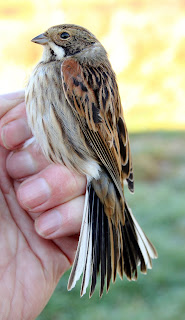Another starry, starry, Van Gogh sky last night and a morning frost meant donning my old woolly balaclava this morning for the 0630 start at Rawcliffe Moss. It was pitch-black when I drove past the open barn as the roosting Barn Owl made a ghostly exit through my headlights then waited on a post for Will to see when he drove past a few minutes later. Alright, the photograph isn’t the actual bird, but is as they say “One I did earlier” and taken in daylight.

My trusty old Hooligan Hat kept ears and face warm from the chilled air as Will and I put up our usual quota of nets whilst listening to Redwings seeping over. Each time we’ve been to the moss in recent weeks we caught both Redwings and Fieldfares in the dark. This morning we caught 15 thrushes before 8am, 7 Redwings and 8 Fieldfares, a catch that kept us mobile for a while but stopped us grabbing a warming coffee. All the Redwings were juveniles this morning and one only of the Fieldfares an adult. As usual at least four Fieldfares escaped from our nets by virtue of their size and weight by having the knack of almost bouncing out of the pocket, especially where four or five are together in the same run of net.




After yesterday’s total of 44 birds we caught another 36 new birds today of 7 species; the above 8 Fieldfare and 7 Redwing, plus 9 Reed Bunting, 6 Goldfinch, 4 Chaffinch, 1 Blue Tit and 1 Tree Sparrow. Needless to say, nil recaptures.



Unlike yesterday the visible migration was unremarkable with many birds arriving from a southerly direction, travelling into the wind, although most of the early thrushes came from the west or north west. In total we counted circa 235 Fieldfares, 100 Redwing and 10 or more Blackbirds, with one flock of Fieldfares numbering approximately 100 birds. Finch movement was also less noticeable with single figure numbers of Brambling, Siskin and Redpoll, but about 50 Chaffinch and 40 Goldfinch.
Apart from thrushes, the most numerous and obvious migrant was Reed Bunting again, and while we caught another 9 today, we estimated at least 45 birds moving through and over the site, some in small groups of fours and fives, with one party of seven individuals.
“Others” today: 2 Yellowhammer, 4 Tree Sparrow, 1 Sparrowhawk hunting thrushes at dawn, 1 Whooper Swan flying west, 20+ Snipe. 1 Stoat heading into the potato field via the ditch.
My old woolly balaclava is showing signs of ageing, wearing thin in the manner of fault bars on the tail of one of the Fieldfare we ringed, so a new warm woolly hat is on my Christmas wish list. This might just make a marginally better gift for me than the surprise the moss gamekeeper plans to present to his wife for Christmas - a new blade for her chainsaw! We still don’t know if he was joking but just in case I’m not calling by to watch her carve the Xmas turkey.











































.jpeg)






.jpg)












